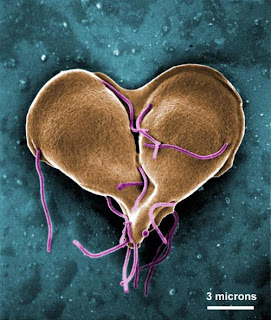Joseph Dean Nestor
Hey there, outdoorsy types!
Whether you get a wild hair for the woods one day or even if you are a chronic adventurer, you can ruin your excursion with just one swallow.
Consuming unsanitary, fecal-contaminated water or food can
lead to diarrhea causing parasitic infections and other serious health risks.
“Hang on now, mister,” you interject, “I boil my water or only drink from clear mountain streams!”
Well, easy there big fella’. Did you know that at high elevations the boiling point of water is lowered, meaning some disease causing critters may still be viable, and even if water looks clean and cold from a stream, disease-causing protozoa (animal-like microscopic organisms [1]) like Giardia lambia may survive for up to 6 months when encysted (think dormant and protected from environment) [2].
“Fine. I’ll just purchase some of those chemical tablets,” say you.
Ah, determined to go a-hiking are you? Well, some critters are tenacious; our newest friend Giardia lamblia and another protozoan Cryptosporidium parvum are resistant to halogen chemical treatments and remain safe in their cysts ready to give you some uncomfortable results. Those tablets may eliminate bacterial risks, but you’re still at risk for diarrhea causing parasites [2]. The chlorine dioxide and silver ion tablets can kill G. lamblia and C. parvum but the process can take up to 4 hours to be determined safe to drink. Additionally, frequent use of a product containing silver may cause a buildup of silver in your body causing a permanent grey-blue coloring of skin and eyes [3].
“What about those portable filter-y thingies?” you demand.
Those can be very helpful in removing the cysts of parasitic protozoa as they are very large, but viruses, bacteria, and harmful solutes remain in the filtered product. You may have realized the safest way to provide yourself with clean, drinkable water while in the wilds is to use more than one approach to ensure cleanliness and safety of the water you drink. A good example is to first filter your water using a carbon/ceramic filter with very small pores. 0.2-0.4 micron pores are an effective way to filter out parasitic cysts as they are much larger than the pores, and then boil the water thoroughly to eliminate any harmful flora that remain.
“Is there any other way; I don’t like to carry more than I have to?” you ask.
You could set up a few solar distillation systems at your camp. These effectively remove all critters and harmful particulates in water at the cost of taking up time to set up and even longer to produce drinkable water. They can be as simple as a single sheet of plastic, and a cup or complex glass and metal framing. Here’s a fun video of the “Mythbusters” fellows using just duct tape and plastic wrap to create a solar distillation unit: http://dsc.discovery.com/tv-shows/mythbusters/videos/jamies-solar-still.htm
Although admittedly a silly premise, you can see the set up
and the condensation process involved. This yields drinkable water from even
dirty, salty water. Additionally, if there isn't any water you can use it over
moist earth. This is quite the handy survival skill to have.
“I don't think I want to go anymore,” you mutter.
Cheer up! You can go, just remember there are always other
options for turning possibly contaminated water (portable UV, 3 step filters,
etc) or you can make sure you have enough water in tow. Enjoy and try not to
become too paranoid.
Here's some pictures of the protozoan critters ready and
waiting to give you diarrhea:
Picture 1: Each G.
lamblia cyst ingested yields two feeding parasites.
Picture 2: Each
feeding form of G. lamblia is capable of asexual replication by binary
fission.
Picture 3: G.
lamblia attaches to the wall of your small intestine.
Picture 4: Each Cryptosporidium
oocyst yields four feeding parasites.
Picture 5: Cryptosporidium
feed and reproduce in your small intestine.
These are just two of many possible organisms that can turn
your vacation adventure into a stay-cation in the porcelain throne room. Stay
safe.
Edutainment links:
In text citations:
[1] Edward Alcamo; Jennifer M. Warner
(28 August 2009). Schaum's Outline
of Microbiology. McGraw Hill
Professional. 144.
[2] Huang DB, White AC (2006). "An updated review on
Cryptosporidium and Giardia". Gastroenterol. Clin. North Am. 35 (2): 291–314.
[3] Lansdown AB (2006). "Silver in health care:
antimicrobial effects and safety in use". Current Problems in Dermatology. Current Problems in Dermatology
33: 17–34.
Picture sources:







No comments:
Post a Comment